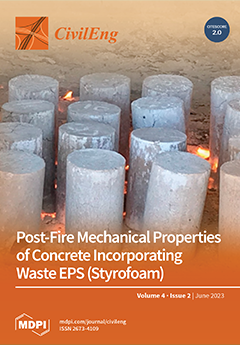Portland cement (PC) is a common material used in civil infrastructure engineering. Cement production emits roughly 2.2 billion tons of CO
2 per year, contributing 8% of global emissions in 2016. This contributes to almost half of the calcination process, and together with
[...] Read more.
Portland cement (PC) is a common material used in civil infrastructure engineering. Cement production emits roughly 2.2 billion tons of CO
2 per year, contributing 8% of global emissions in 2016. This contributes to almost half of the calcination process, and together with thermal combustion, clinker generation could be responsible for 90% of the sector’s emissions. One effective technique for dealing with these industrial by-product wastes is to employ them to make cement replacements such as concrete and mortar, which can be used in a variety of applications. As a result, the purpose of this research is to review the current advancements, challenges, and future perspectives on the utilization of agro-industrial waste (AIW) produced around the world in cement-based products. Geopolymers (GPs), on the other hand, reduce carbon dioxide emissions and have the potential to be a complete or partial replacement for PC in the construction sector. The GP technology enables the use of AIW in combination with an alumina–silicate (A–S) phase with minimal environmental impact. GP-cement is mostly produced by activating alkali silicates or alkali sols with secondary raw materials such as calcined clays, fly ash (FA), zeolite, metakaolin, etc. Mixing various resource materials, including additives, A–S, and alkali sols, alkali concentrations, optimizing the curing temperature, the SiO
2/Na
2O ratio, microstructural behavior, and other factors, results in GP-cement with outstanding mechanical and durability characteristics. The review concludes that AIW-based geopolymer composites have shown promising results in terms of their mechanical properties, durability, and environmental sustainability, which makes them emerge as promising future building materials with applications in a wide range of industries.
Full article





